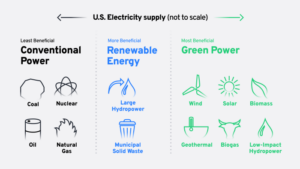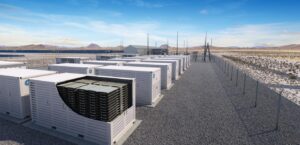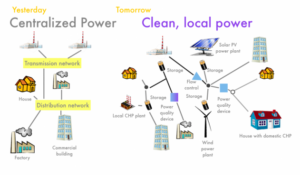Renewable energy adoption has taken center stage in the sustainability conversation as concern over human impact on the environment has reached an all-time high and decarbonization of the power sector has become a priority. Sustainability trends in clean energy technologies have already made an incredible impact on the type of energy we use and how it is created. In fact, U.S. energy from solar and wind have almost quadrupled in the past 10 years. Additionally, 70% of American utilities have committed to clean energy goals, including net zero carbon emissions plans.
Green energy solutions such as solar, wind, low-impact hydroelectric, geothermal, biogas and other tactics are vital to the mitigation of climate change, atop the list of sustainability trends. The journey toward widespread adoption of clean energy technologies is not without challenges. As governments, businesses and communities navigate the complexities of transitioning from fossil fuels to green energy solutions, an essential element of success will be effective communication from the power generation sector. Highlighting sustainability initiatives isn’t merely a matter of corporate branding, it’s a marketing approach that will build trust and solidify a company’s position as a leader and pioneer in the sustainable energy landscape.
Before we dive into marketing techniques to get the media’s attention, it’s important to understand sustainability trends in clean energy technologies.
Keep reading for a quick foundation in power generation sector green energy solutions, followed by marketing strategies.
Image credit: Klima
Increased focus on green energy solutions
There is a growing emphasis on clean energy technologies and energy efficiency innovations in the power generation sector, and for good reason. Global temperatures are rising, and this change is causing a variety of natural phenomena. In July of 2023, North America had its second warmest July on record, and across the globe record high temperatures were set. July also set a record for the highest monthly sea surface temperature globally. Extreme weather events have become more common including more severe droughts, stronger storms and floods, intense snow and freezing temperatures and more destructive wildfires.
Green energy solutions and clean energy technologies could help us curtail the effects of climate change in addition to other benefits including energy diversification and economic development. The Environmental Protection Agency (EPA) notes some of benefits of clean energy technologies efforts and following sustainability trends:
- Generating energy that produces no greenhouse gas emissions from fossil fuels and reduces some types of air pollution
- Diversifying energy supply and reducing dependence on imported fuels
- Creating economic development and jobs in manufacturing, installation and more
By implementing clean energy technologies, power generation companies can show that they care about the future of the planet and preserving key natural habitats while also supporting economic growth and job creation.
Image credit: GE
Energy storage advancements
It’s not just the generation of power, but green energy solutions must also address the storage of that power as part of the clean energy technologies movement. There have been several advancements in energy storage technologies which have had an integral impact on sustainability. Take solar power, for instance. It needs to be stored so that it can be accessed at night or during days with shorter sun exposure. Storage is vital for the advancement of clean energy technologies and balancing the supply and demand of green energy generation.
World Economic Forum explains four common storage approaches for green energy solutions:
Pumped hydro – Storing water in a reservoir which is released through turbines during periods of high demand and pumped uphill during low demand.
Batteries –Grid-scale battery facilities are being built in many countries including the U.S. and California has the world’s largest battery storage facility with a 300-megawatt lithium-ion battery.
Thermal energy – Used in buildings and industrial processes, thermal energy storage traps surplus energy from renewable sources or waste heat for use later.
Mechanical energy – This approach uses motion or gravity to store electricity, utilizing a flywheel or in some cases pressurized air or gas which turns a turbine to generate power.
Clean energy technologies in the storage vertical are essential to the continued adoption of green energy solutions. American Clean Power notes that improving energy storage will:
- Enhance grid reliability by ensuring dependable electricity delivery
- Provide a more flexible and nimble power grid that can manage supply and demand
- Reduce consumer costs by storing energy when prices are low and delivering it when there would normally be higher rates
- Protect productivity for businesses and important infrastructure by being able to tap stored energy during brief outages
- Minimize the negative impact of power outages on consumers by being able to access stored energy
- Make clean energy more viable by being able to use renewables such as solar or wind when the sun has set or there is no wind blowing
- Smooth out variable energy by covering intermittent resources during periods of low production
- Deliver higher energy density as battery storage systems take up much less space compared to other generation systems
Decentralized energy generation
When you think about the power grid, it’s likely you think of a few big energy generation power plants that have electrical wires fanning out over a widespread area. That is called centralized power and is what most of the current U.S. grids utilize. The problem with this structure is that when one power plant fails or has an outage, it affects enormous amounts of the population.
Centralized power might also only use a couple types of power generation for most of the electricity production. If one or both are compromised, the whole system can be shut down. This is what happened with the Texas power outage of 2021. Neither form of power generation it had set up was able to withstand the freezing winter storm temperatures, so there was a catastrophic failure of the grid.
Decentralization uses numerous and varied green energy solutions to generate power and moves those clean power technologies closer to the people who use them. This way there is less effort in distribution, and an outage affects a smaller area. Additionally, storage facilities can be connected to multiple areas, so that backup power can be routed in to cover while any repairs are taking place.
Image credit: Institute for Local Self-Reliance
Decentralized energy generation is often referred to as a microgrid. A microgrid is simply a network of smaller electricity generation plants of varied sources, which mostly operate independently, but can all be connected through storage facilities to create a larger electrical support system. These are intrinsic to current sustainability trends.
Marketing techniques to pique media interest
It’s extremely important for companies in the power generation sector to craft compelling messaging and content to promote the clean energy technologies and the green energy solutions being implemented. Sustainability is an area of interest for many consumers, as a 2022 survey showed that half of participants believe that climate change is one of the most important social issues for companies to address. It makes sense that clean energy technologies would be a significant area of focus for power companies, as their products and practices directly impact the environment and climate.
So, how can the power generation vertical reach customers with its sustainability message and share information about groundbreaking clean energy technologies? Here are four strategies to employ:
- Utilize a comprehensive thought leadership program
Positioning the brand or power company as industry experts when it comes to clean energy technologies builds trust through informative content. Power generation companies can use white papers, blog posts, case studies and other forms of content to establish expertise and discuss green energy solutions. Ideally, the company will find one or two people to be the spokesperson (people) of the company. Thought leadership plays an important role in capturing media interest. When media are covering timely topics or news, they are often looking for reliable and respected sources to quote. Creating valuable thought leadership content in advance of these conversations can open the door for interviews, quotes, stories and more, helping to establish your company as an industry innovator in clean energy technologies.
2. Cultivate strong media relationships
To gain the exposure the brand wants, it’s smart to build strategic relationships with relevant industry trades and green energy solution/sustainability reporters. As noted above, thought leadership is a good way to capture the media’s attention about clean energy technologies. Then, journalists might reach out to your company for expert commentary, deskside interviews and turnkey content to further foster the relationship and supplement their reporting. To be at the top of the media relationships game, power generation companies should have a comprehensive media kit readily available that focuses on clean energy technology efforts, as well as create and promote timely, useful content to generate media interest surrounding green energy solutions.
3. Engage with key stakeholders
A good strategy is to engage with key stakeholders to amplify the brand’s sustainability message. This could be members of the C-suite, producers, regulatory bodies, distribution centers or even customers and influencers who are passionate about clean energy technologies. Stakeholder engagement can attract media attention. Some strategies that can foster support and collaboration with stakeholders include thought leadership content from outside of the company in collaboration with the stakeholder, influencer content, explainer videos hosted by the stakeholder or other owned media that can be shared.
4. Leverage social media
Speaking of sharing content, social media is a powerful tool for increasing visibility into organizational sustainability initiatives. Power generation companies will be able to cast a wider audience net and generate buzz about clean energy technologies through social media platforms and advertising. Owned social media channels are an ideal place to post created content, and marketing dollars can be used to serve that content to individuals that are not yet following the company. Social media also provides a direct line of communication to the target audience (likely customers), allowing the power company to answer questions and help prospects understand how clean energy technologies are beneficial and to share the brand’s green energy solutions/sustainability message.
Power up marketing for clean energy technologies and sustainability
With so many sustainability trends including an increased focus on renewables, advancements in storage and the decentralization (or localization) of power, there’s a lot of clean energy technology news. Companies in the power generation sector can implement effective marketing techniques to drum up media interest in green energy solution trends and earn coverage and placements. Key strategies to grab media attention include utilizing thought leadership, cultivating media relationships, engaging with stakeholders and leveraging social media to promote sustainability trends and initiatives, along with generating media attention around clean energy technologies.
The experts at Beyond Fifteen can help your power generation company pique media interest with superior content, thought leadership initiatives and media relations strategy. Connect with us to learn more!










